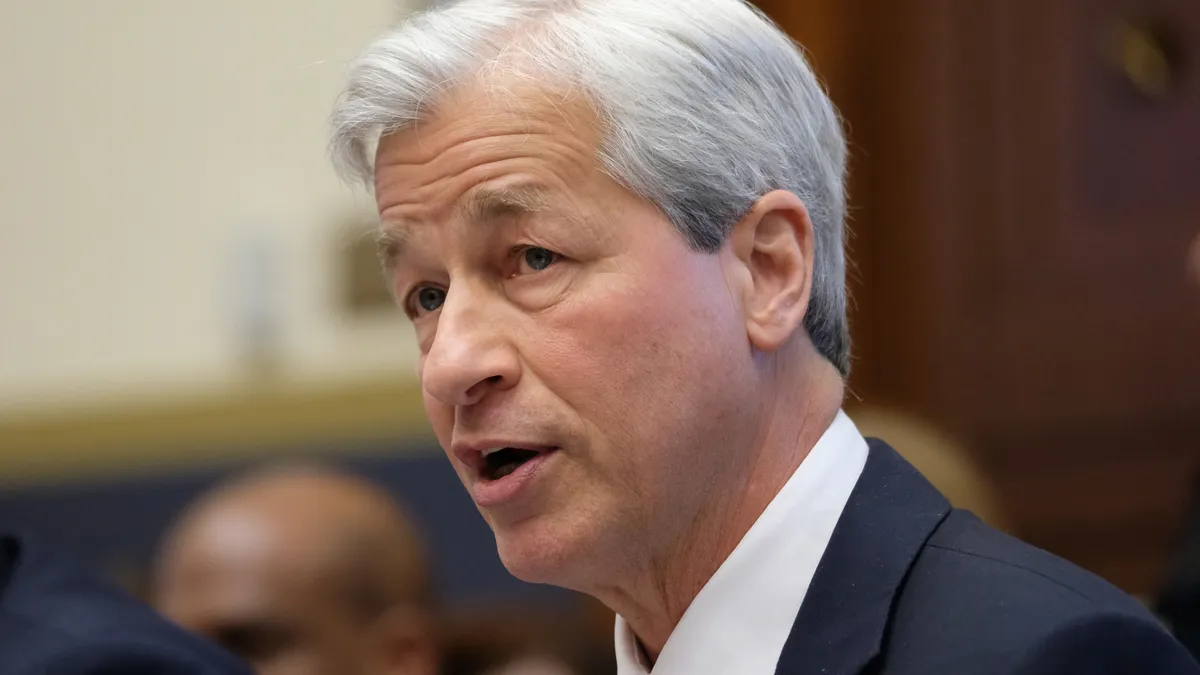JPMorgan Chase reported Tuesday that it transferred 398,708 shares of company stock to CEO Jamie Dimon last week. The shares — part of Dimon’s 2018 compensation package — have a value of nearly $56 million, Bloomberg reported. That’s more than twice the $24.5 million Dimon was promised that year in performance share units.
To be clear, JPMorgan Chase said at the time that it could bump up the number of shares — originally 243,697 — by up to 50% if the bank hit a predetermined target for return on equity, among other factors.
Compounding that, JPMorgan’s stock price has risen roughly 38% since the 2018 compensation deal was struck.
Just like that, a package once thought to encompass $31.5 million grew to north of sixty, when Dimon’s $1.5 million salary and $5 million cash bonus are included.
Tuesday’s filing isn't an outlier. Dimon’s incentive award for 2017 paid out last March to a value of $51 million, according to Bloomberg. That’s up from an original estimate of $23 million.
This emphasizes the "variable" in variable pay — and drives home the idea that value is a construct, and the only opinion that matters in value is the buyer’s.
In Dimon’s case, the buyer is JPMorgan’s board — which made it clear last July, when it handed the CEO a "special award," that it aimed to buy his services for at least another five years.
The M&A value spectrum
Indeed, the concept of value may have few constants. To illustrate, let’s look at mergers and acquisitions — specifically, contrasting two deals proposed within roughly three months of each other by two banks, each taking on the U.S. retail footprint of a foreign entity looking to exit consumer banking stateside.
Bank of the West, the San Francisco-based U.S. arm of French juggernaut BNP Paribas, counted $105 billion in assets when Bank of Montreal (BMO) bid $16.3 billion for it in December. To be fair, total assets are not the only factor that goes into setting value. But consider, U.S. Bank, in September, proposed to acquire MUFG Union Bank — and its $133 billion in assets — for $8 billion, less than half of Bank of the West’s commanding price.
Two other recent proposed acquisitions of banks carrying similar asset totals show the BMO and U.S. Bank deals may simply represent the high and low ends of a value spectrum. PNC paid $11.6 billion in late 2020 to buy BBVA’s $101 billion-asset U.S. retail footprint. More recently, TD said it would purchase $89.1 billion-asset First Horizon for $13.4 billion.
The moral may be: It’s not what a bank or a banker is worth; it’s what that bank or banker is worth to the buyer.
Asterisks
And compensation figures, much like athletic records, may do well to include asterisks. Value can depreciate, too. Some Syracuse University basketball fans may assert that men’s head coach Jim Boeheim has won 1,099 games over his career. But the NCAA showed it didn’t see any value in 101 of those victories when it determined the program violated regulations in the mid-2000s and early 2010s.
Likewise, Barry Bonds may have hit more home runs than any baseball player ever. And if the specter of performance-enhancing drugs weren’t a question, he would have been a first-ballot lock. But baseball’s buyers — in this case, sportswriters who vote annually — have deemed the home run total not valuable enough on its own to warrant enshrinement in the Hall of Fame.
Banks, too, can value certain qualities or people less over time. Barclays last month froze the unvested portion of former CEO Jes Staley’s deferred pay "pending further developments" that stem from U.K. regulators’ investigation into his ties with late convicted sex offender Jeffrey Epstein. That means Staley could lose out on $32 million worth of Barclays stock.
The bank clearly thought, at one point, Staley was worth it. And it may still — depending on the outcome of the case and the associated optics.
Goldman Sachs, in another example, has shown it espouses an idea that value is tied to loyalty. The bank reportedly locked unvested compensation it once promised to Gregg Lemkau and Eric Lane, two executives who left Goldman in 2020 and 2021 for firms that traditionally wouldn’t be seen as direct competitors.
The executives signed contracts indicating the bank has the right to withhold unvested funds, but historically, Goldman had let departures to non-competitors slide. Perhaps feeling betrayed by these particular cases of executive flight, Goldman adhered to a stricter interpretation of the contracts.
Lemkau and Lane are reportedly not alone. Goldman also allegedly blocked former Marcus executives Omer Ismail and David Stark from cashing out stock bonuses that had vested and been taxed up to five years earlier and banished them from company-led alumni events. Ismail and Stark left Goldman in early 2021 for Walmart’s fintech startup.
As it turns out, Dimon may end up pocketing a figure closer to what was agreed for 2018. More than half of the shares reported Tuesday were withheld for taxes, Bloomberg reported.














